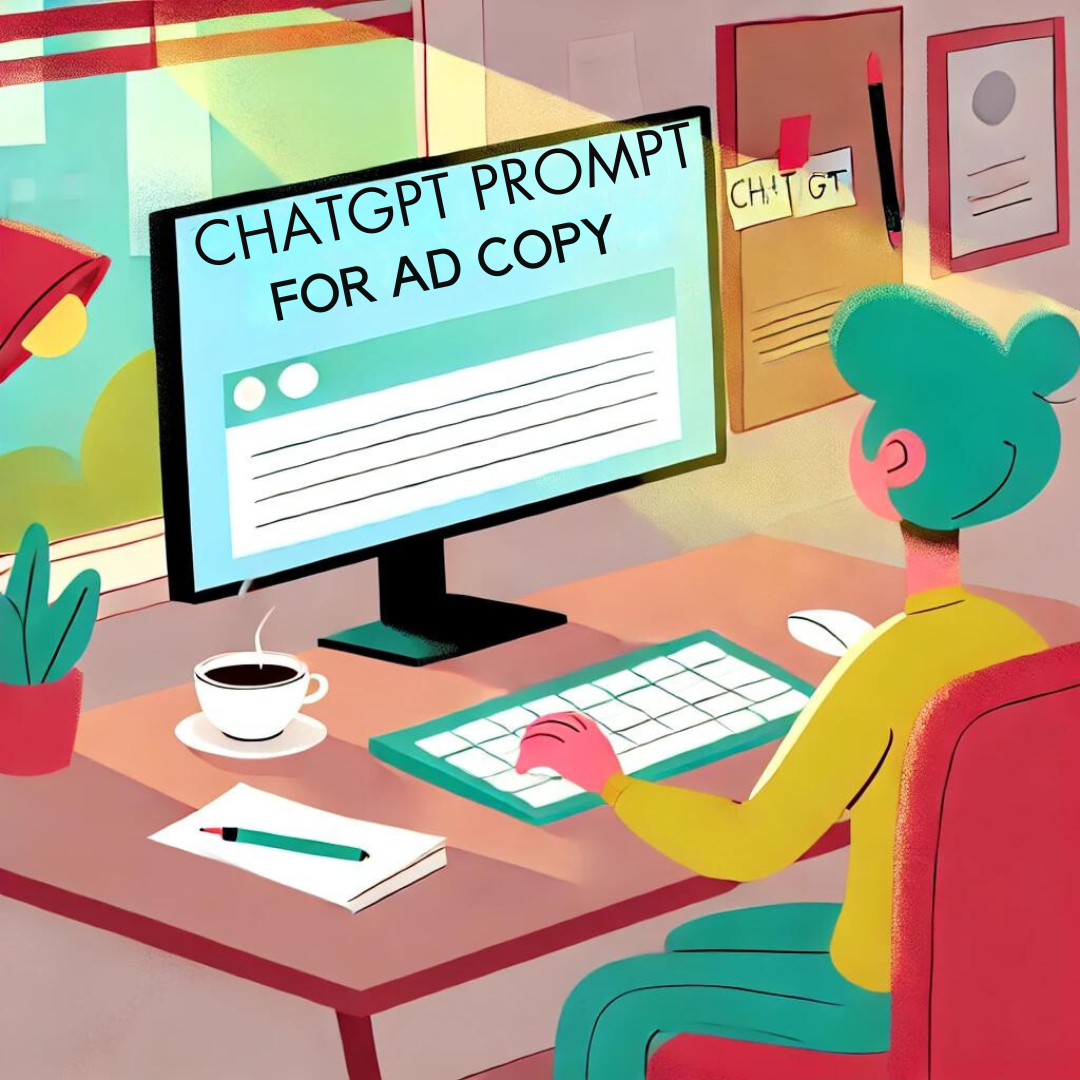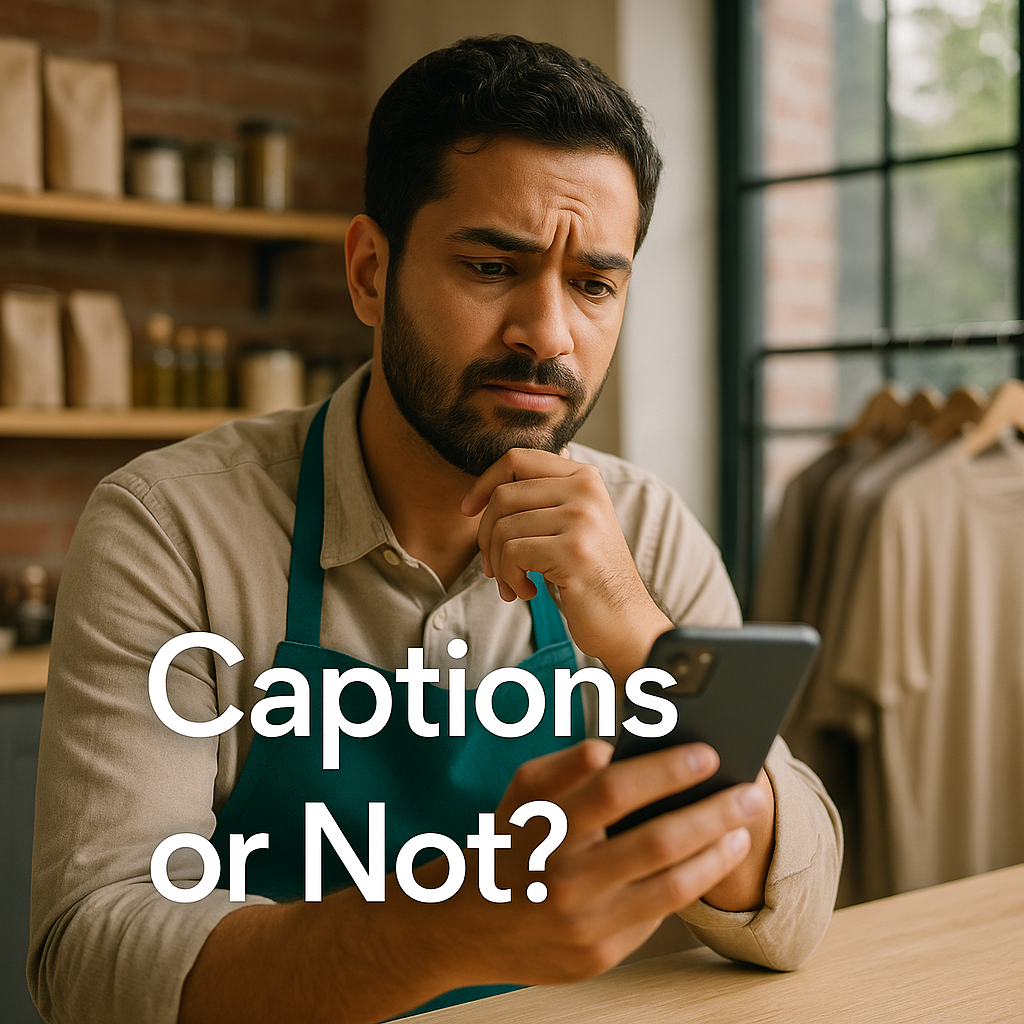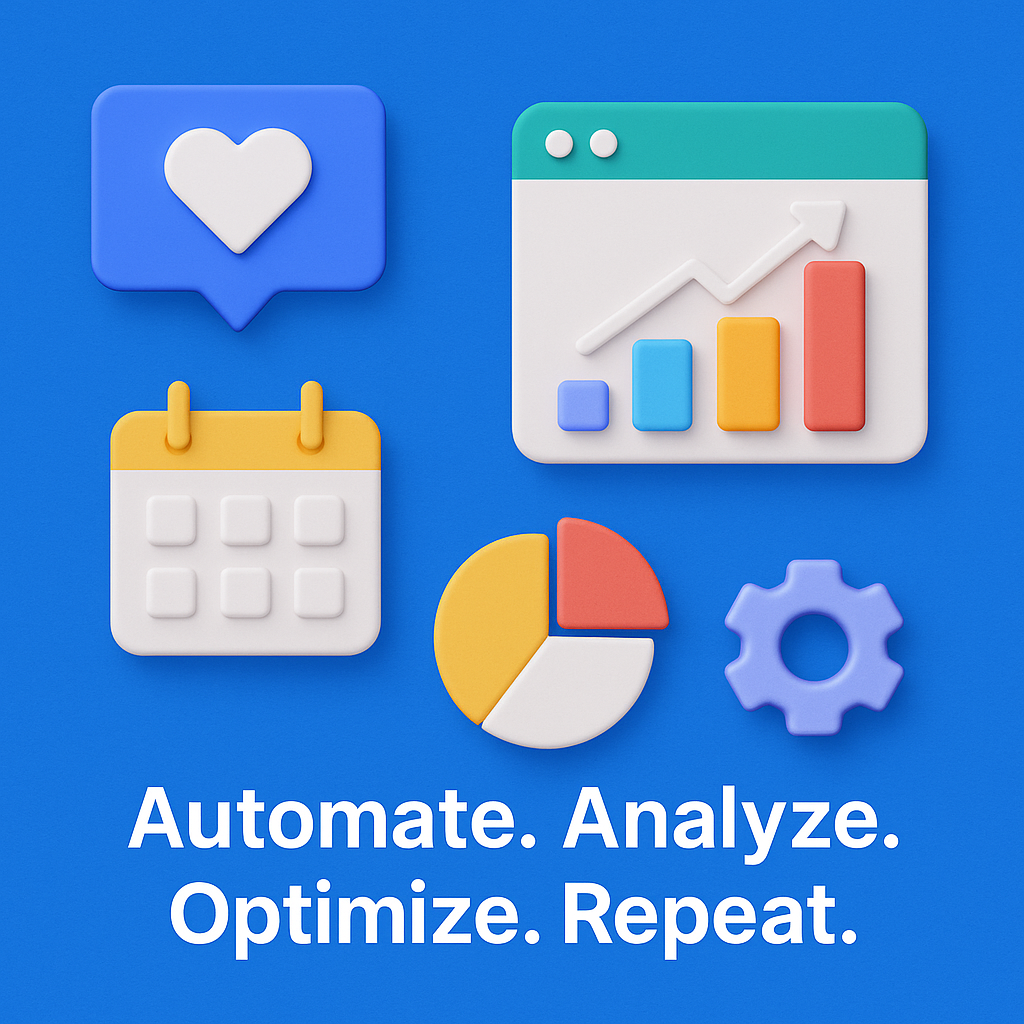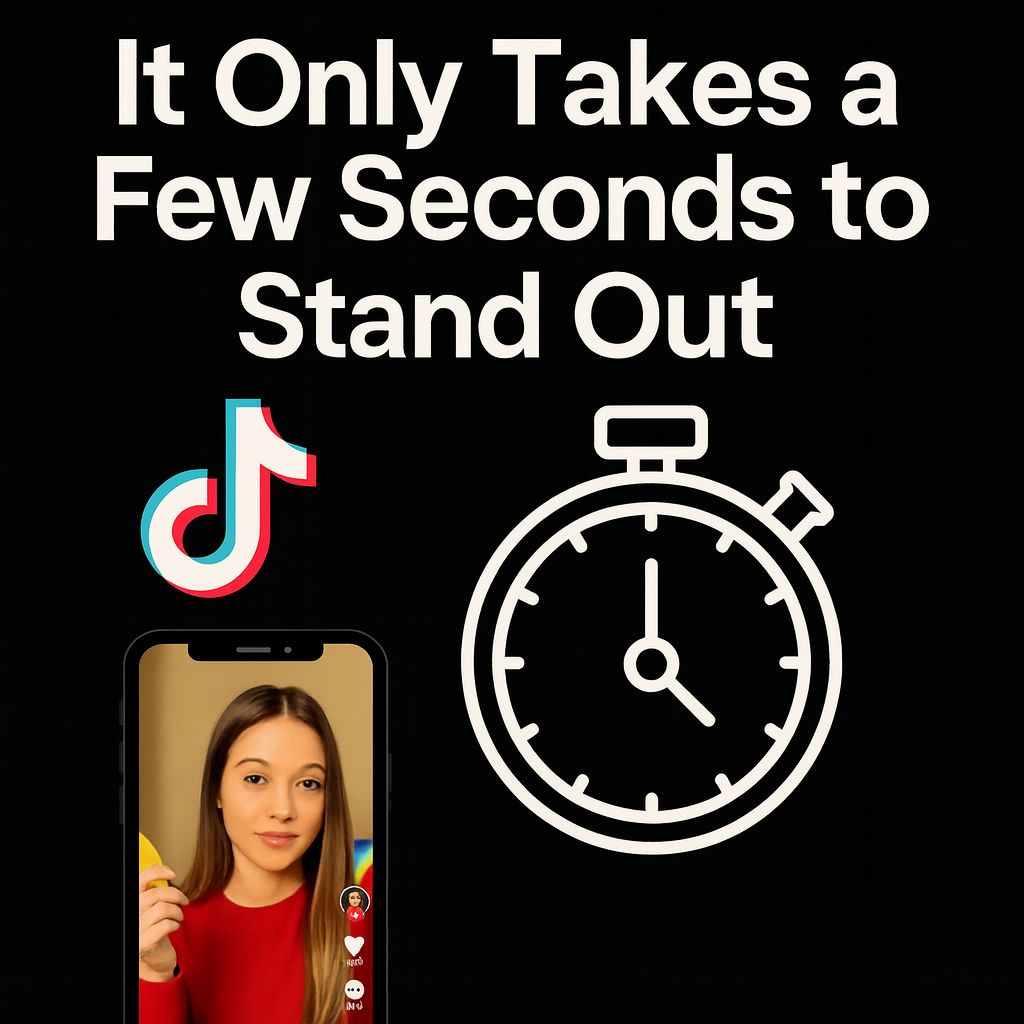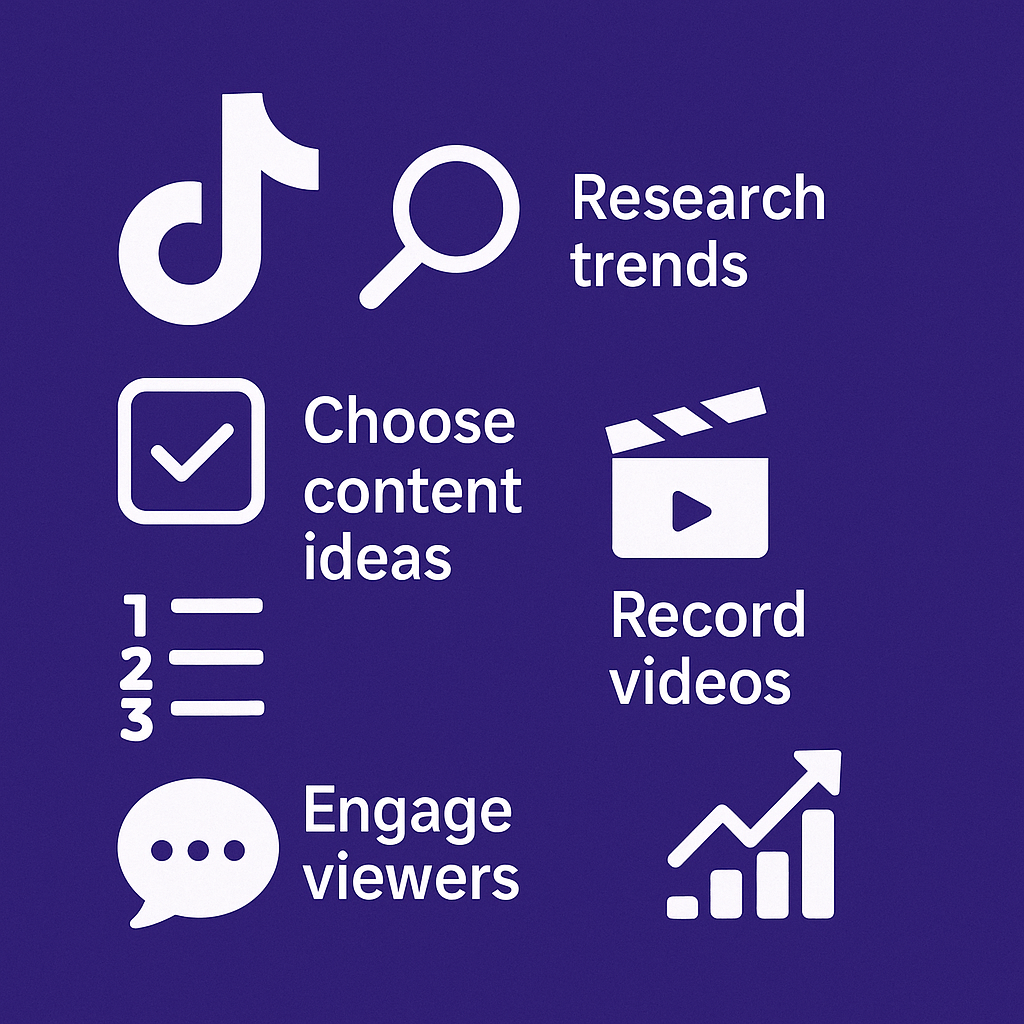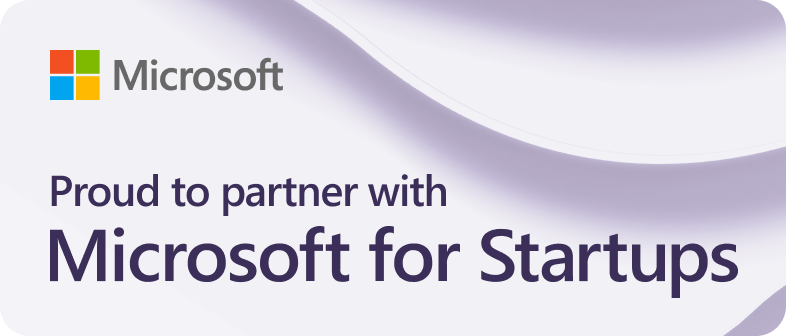Ever feel like your ad copy is just not hitting the mark? You’re not alone! Crafting killer ad copy that grabs attention and drives results is tough—but it doesn’t have to be.
What if I told you that with just the right prompt, you could turn your words into a powerful tool for converting clicks into customers? That’s where the ChatGPT prompt hack comes in.
In this post, I’m going to show you exactly how to create irresistible ad copy using ChatGPT prompt templates.
We’ll dive into some smart, easy-to-use ChatGPT prompt examples that will make your ads stand out, whether you’re targeting Google Search, Meta, or TikTok.
I’ll break down the key components that make these prompts so effective and give you 7 solid examples that you can start using right away.
So, if you’re ready to turn bland into brilliant and start seeing real results from your ads, keep reading. This is the guide you’ve been waiting for.
The Power of ChatGPT in Ad Copywriting
What makes ad copy truly effective? It’s not just about the words you use—it’s about how those words resonate with your audience.
But finding that sweet spot can be challenging. That’s where ChatGPT for marketing comes into play. This AI-powered tool isn’t just another gadget in your digital marketing strategy toolbox; it’s your shortcut to creating ad copy that doesn’t just sound good but works.
ChatGPT allows you to streamline the creative process by generating ad copy tailored to your specific needs, whether it’s for Google Search, Meta, or TikTok.
The real magic, however, happens when you feed ChatGPT the right prompts. A carefully crafted prompt sets the stage for AI to deliver content that’s sharp, engaging, and perfectly aligned with your marketing goals.
Do you struggle with managing multiple social media platforms for your brand's presence?
The Sociosight app can help you simplify the process and save you time. With Sociosight, you can publish, schedule, and monitor posts and engage with your followers across multiple social media platforms, all from one dashboard.
Get started today with a free sign-up!
Register Now for Free

In this post, I’ll show you two essential ChatGPT prompt templates—one that gives you a comprehensive approach and another for quick, effective results.
We’ll see how these prompts can be adapted to create winning ad copy for different platforms and explore the key elements that make them so powerful.
So, let’s dive in and see how you can leverage ChatGPT to take your ad copywriting to the next level.
Introducing the ChatGPT Prompt Templates
Now, let’s get to the good stuff: the ChatGPT prompts that will help you craft killer ad copy.
Whether you prefer a more detailed approach or need something quick and effective, I’ve got you covered with two versatile templates.
Table of Contents
The Long Prompt Template
This template is for those times when you need to go all-in on customization. It gives ChatGPT everything it needs to create highly targeted, platform-specific ad copy that’s finely tuned to your brand’s voice and your audience’s needs.
Template:
“You are an expert ad copywriter creating a high-impact ad for [Google Search Ads, Meta Ads, TikTok Ads]. The brand offers [product/service description], targeting [specific audience profile] who are in the [specific customer journey stage: Awareness, Consideration, Decision] and experiencing [key pain points or desires]. The ad will be displayed to audiences in [location: specific country, region, or worldwide]. Use the [chosen copywriting formula: AIDA, PAS, FAB, PASTOR, etc.] with a [selected style: storytelling, conversational, persuasive, etc.] approach. The tone should be [desired tone: formal and professional, fun and relaxed, inspirational, etc.], reflecting the brand’s [USP or key features]. Start with a [provocative, attention-grabbing, clickbait, bold, humorous, etc.] headline or hook to capture interest. Incorporate [emotional triggers, social proof, cultural references, etc.] as needed. Finish with a compelling call to action that encourages the audience to [specific action: click, sign up, purchase, etc.], ensuring the message is [simple and direct, detailed and informative, etc.]. Consider the [visual/multimedia elements] that align with the ad format and platform. Also, consider the maximum number of characters allowed by the ad platform.”
This prompt is your go-to for when you need to cover all the bases. It allows for deep customization, giving ChatGPT all the details necessary to generate a polished, effective ad.
The Short Prompt Template
On the other hand, sometimes you just need something quick and effective. This short prompt template is perfect for those situations where speed is of the essence, but you still need the ad copy to pack a punch.
Template:
“Write an ad for [Google Search Ads, Meta Ads, TikTok Ads] promoting [product/service] to [target audience] in the [customer journey stage] who are facing [key pain points or desires] in [location]. Use the [copywriting formula] with a [style] and [tone]. Start with a [headline type] headline and include a strong call to action that encourages the audience to [desired action]. Also, consider the maximum number of characters allowed by the ad platform.”
This streamlined prompt gets straight to the point, making it perfect for generating ad copy in a hurry without sacrificing quality.
Understanding the Key Components of a ChatGPT Prompt
Creating a killer ad isn’t just about choosing the right words—it’s about structuring those words in a way that maximizes impact.
Let’s break down the key components of a ChatGPT prompt for business so you can understand how each part plays a crucial role in crafting effective ad copy.
Copywriting Formulas
Copywriting formulas are the backbone of your ad. They provide a proven structure to guide your messaging and ensure that your copy is persuasive and effective. Here are a few key formulas:
![7 ChatGPT Prompt Examples for Creating Killer Ad Copy That You Should Never Ignore[Guide with Infographic] 1 ChatGPT Prompt Example - Sociosight.Co](https://sociosight.co/wp-content/uploads/2024/08/1-410x1024.png)
- AIDA (Attention, Interest, Desire, Action): This classic formula captures attention, generates interest, builds desire, and drives action. It’s great for ads where you need to guide the audience through a clear, logical progression.
- PAS (Problem, Agitate, Solution): This formula focuses on identifying a problem, agitating it to emphasize its severity, and then presenting your product or service as the solution. It’s particularly effective for products or services that solve specific pain points.
- FAB (Features, Advantages, Benefits): This formula highlights the features of your product, explains the advantages of those features, and then ties it all together by showing how the benefits improve the customer’s life. It’s ideal for product-focused ads.
- PASTOR (Problem, Amplify, Story, Testimony, Offer, Response): A more detailed formula that not only addresses the problem but also amplifies its importance, tells a story, provides social proof and finishes with a compelling offer. This works well for long-form ads or where you have more room to tell a narrative.
- SLAP (Stop, Look, Act, Purchase): The SLAP formula is a straightforward and highly effective structure, particularly for ads that need to quickly grab attention and drive immediate action.
- Stop: The ad starts by catching the audience’s eye with something unexpected, bold, or provocative.
- Look: Once you’ve captured their attention, the next step is to hold it by making them curious or interested in what you have to offer.
- Act: This is where you prompt the audience to take a specific action, whether it’s clicking a link, signing up, or learning more.
- Purchase: Finally, you encourage the audience to make a purchase or take the ultimate step you want them to complete.
Styles
![7 ChatGPT Prompt Examples for Creating Killer Ad Copy That You Should Never Ignore[Guide with Infographic] 2 ChatGPT Prompt Example - Sociosight.Co](https://sociosight.co/wp-content/uploads/2024/08/2-410x1024.png)
The style of your ad sets the tone for how your message will be received. Different styles can evoke different responses from your audience:
- Storytelling: Engages the audience by telling a story. This style is effective for creating an emotional connection and is particularly useful for brand-building ads.
- Conversational: A relaxed, informal style that makes the ad feel like a one-on-one conversation. This can make the audience feel more connected to the brand.
- Persuasive: Focuses on convincing the audience through logic, benefits, and emotional appeal. It’s direct and to the point, often used in ads that need to drive conversions.
- Urgent: Uses time-sensitive language to prompt immediate action. Great for flash sales or limited-time offers.
- Humorous: Add a touch of humor to make the ad memorable and engaging. It’s risky but can be highly effective when done right.
Tones
![7 ChatGPT Prompt Examples for Creating Killer Ad Copy That You Should Never Ignore[Guide with Infographic] 3 ChatGPT Prompt Example - Sociosight.Co](https://sociosight.co/wp-content/uploads/2024/08/3-410x1024.png)
The tone is the emotional coloring of your ad copy. It sets the mood and influences how your audience perceives the message:
- Formal and Professional: Best for industries where trust and credibility are paramount, like finance or healthcare. It conveys authority and expertise.
- Fun and Relaxed: Suited for lifestyle brands, entertainment, or any product that appeals to a more casual audience. It makes the brand feel approachable and relatable.
- Inspirational: Motivates and uplifts the audience, often used in ads promoting self-improvement, health, or wellness products.
- Trustworthy/Authoritative: Establishes credibility and reliability. Perfect for brands that need to reassure their audience, such as tech or legal services.
- Playful: Light-hearted and fun, making the brand feel youthful and energetic. It’s ideal for products aimed at a younger demographic.
Headlines/Hooks
![7 ChatGPT Prompt Examples for Creating Killer Ad Copy That You Should Never Ignore[Guide with Infographic] 4 ChatGPT Prompt Example - Sociosight.Co](https://sociosight.co/wp-content/uploads/2024/08/4-410x1024.png)
Your headline or hook is the first thing your audience sees, so it has to grab attention immediately. Different types of headlines serve different purposes:
- Provocative: Challenges the reader or stirs curiosity, making them want to know more.
- Attention-grabbing: Uses bold or surprising statements to catch the eye, perfect for standing out in a crowded feed.
- Clickbait: Highly engaging, often using curiosity or shock value to compel clicks. Must deliver on its promise to avoid disappointing the audience.
- Bold: Makes a strong statement, asserting the brand’s stance or value proposition.
- Humorous: Lightens the mood, making the ad more memorable and enjoyable.
- Curiosity-Inducing: Piques interest by hinting at something intriguing, encouraging the audience to read further.
Calls to Action (CTAs)
![7 ChatGPT Prompt Examples for Creating Killer Ad Copy That You Should Never Ignore[Guide with Infographic] 5 ChatGPT Prompt Example - Sociosight.Co](https://sociosight.co/wp-content/uploads/2024/08/5-410x1024.png)
A strong CTA is essential to converting interest into action. It should be clear, concise, and aligned with your campaign goals:
- Click: Encourages the audience to click through for more information or to make a purchase.
- Sign Up: Invites the audience to join a mailing list, register for an event, or create an account.
- Purchase: Directs the audience to buy a product, often used with phrases like “Buy Now” or “Shop Today.”
- Download: Prompts the audience to download an app, e-book, or other digital content.
- Subscribe: Encourages long-term engagement by asking the audience to subscribe to a service or content stream.
- Learn More: Offers more information, ideal for more complex products or services that require explanation.
Target Audience Profile
Understanding who you’re talking to is half the battle in creating effective ad copy. This is where defining a customer persona becomes crucial.
A customer persona is a detailed, semi-fictional representation of your ideal customer, based on market research and real data about your existing customers. It includes demographics like age, gender, location, and income level, as well as psychographics like interests, behaviors, and pain points.
But it doesn’t stop there. To craft truly impactful ad copy, you also need to consider the customer journey—the stages your audience goes through from becoming aware of your product to making a purchase.
Each stage of the customer journey requires a different messaging approach:
- Awareness Stage: At this point, the customer is just becoming aware of a problem or need. Your ad copy should be educational, highlighting the problem and positioning your product as a potential solution.
- Consideration Stage: Here, the customer is researching and comparing options. Your ad copy should emphasize your product’s unique selling proposition (USP) and key features, helping to differentiate it from competitors.
- Decision Stage: The customer is ready to make a purchase. Your ad copy should include strong calls to action (CTAs) and social proof to reassure them that they’re making the right choice.
Carefully crafting your ChatGPT prompts to include specifics about your customer persona and their stage in the customer journey will ensure that your ad copy speaks directly to their needs, desires, and pain points. This targeted approach will make your ads more relevant and persuasive, ultimately driving better results.
Unique Selling Proposition (USP) or Key Features
Your USP is what sets your product or service apart from the competition. It’s the unique benefit that only your brand can offer. Highlighting your USP or key features in your ad copy not only differentiates your brand but also gives your audience a clear reason to choose you over others.
Emotional Triggers
Emotional triggers are powerful tools in copywriting techniques that tap into the emotions of your audience to drive action.
By understanding and leveraging these triggers, you can create ad copy that resonates on a deeper level, motivating your audience to engage, click, or buy.
Here are some common types of emotional triggers and how they can be used effectively in ad copy:
Fear of Missing Out (FOMO)
- Description: FOMO is a powerful motivator that taps into the fear of being left out or missing an opportunity. It’s commonly used in ads to create urgency and encourage quick action.
- Example Use: “Don’t miss out on our limited-time offer—only a few spots left!”
- When to Use: FOMO is particularly effective in flash sales, exclusive offers, and time-sensitive promotions where you want to prompt immediate action.
Security and Safety
- Description: This trigger appeals to the need for safety and security, whether it’s physical, financial, or emotional. Ads using this trigger often emphasize protection, reliability, and peace of mind.
- Example Use: “Protect your family with our top-rated home security system—because their safety is our priority.”
- When to Use: Ideal for products or services that offer protection, insurance, financial stability, or safety-related benefits.
Belonging and Community
- Description: People have a natural desire to belong to a group or community. This trigger taps into the audience’s need for social connection, acceptance, and shared identity.
- Example Use: “Join a community of like-minded individuals and be part of something bigger.”
- When to Use: Effective for brands that promote social causes, membership programs, or products that foster a sense of belonging.
Excitement and Adventure
- Description: This trigger appeals to the desire for new experiences, thrill, and excitement. It’s about offering something that stands out from the routine and sparks curiosity or adventure.
- Example Use: “Unleash your adventurous side—discover destinations you’ve never imagined!”
- When to Use: Best suited for travel, lifestyle, and entertainment brands, or any product that offers a new, exciting experience.
Trust and Credibility
- Description: Building trust and credibility with your audience is crucial, especially for brands in industries like healthcare, finance, or tech. This trigger reassures the audience of the brand’s reliability, expertise, and integrity.
- Example Use: “Trusted by over a million customers worldwide—your satisfaction is guaranteed.”
- When to Use: Effective for products or services where trust is a significant factor in the purchasing decision.
Nostalgia
- Description: Nostalgia triggers fond memories of the past, often evoking emotions tied to simpler or happier times. It’s a powerful way to create a connection with the audience by reminding them of positive experiences.
- Example Use: “Rediscover the flavors of your childhood with our classic recipes.”
- When to Use: Ideal for brands that have a long history, offer retro or vintage products, or want to connect with an older demographic.
Happiness and Joy
- Description: This trigger focuses on creating positive emotions, such as happiness, joy, and delight. Ads that make people feel good are more likely to be remembered and shared.
- Example Use: “Brighten your day with our fun and colorful designs!”
- When to Use: Perfect for lifestyle, fashion, and entertainment brands, or any product that aims to bring happiness to the consumer.
Empowerment
- Description: Empowerment triggers inspire and motivate the audience to take control, make decisions, and feel capable. This trigger is about boosting confidence and encouraging action.
- Example Use: “Take charge of your health—start your fitness journey with us today!”
- When to Use: Effective for personal development, fitness, and self-help products, or any service that promotes independence and self-improvement.
Guilt
- Description: While it must be used carefully, guilt can be an effective motivator by making the audience feel responsible for taking action or avoiding negative consequences.
- Example Use: “Don’t let your loved ones down—get life insurance today to secure their future.”
- When to Use: Best suited for charitable causes, health-related products, or anything that requires the audience to consider the impact of their inaction.
Curiosity
- Description: Curiosity is about tapping into the audience’s desire to know more or uncover something intriguing. It’s a great way to draw people in and keep them engaged.
- Example Use: “You won’t believe what happens when you switch to our service—find out now!”
- When to Use: Effective for teaser campaigns, product launches, or any scenario where you want to build anticipation and drive clicks.
Greed
- Description: Greed triggers the desire to gain more—whether it’s more value, more savings, or more rewards. It’s often used in ads that emphasize great deals or exclusive offers.
- Example Use: “Get double the rewards when you shop today—limited time only!”
- When to Use: Perfect for sales, discounts, loyalty programs, or any offer that provides significant value or benefits.
Sadness and Compassion
- Description: This trigger evokes empathy and a desire to help or make a difference. It’s commonly used in ads that support charitable causes or promote social responsibility.
- Example Use: “Help us provide clean water to those in need—every donation makes a difference.”
- When to Use: Best for non-profits, social enterprises, or campaigns that aim to raise awareness and drive action for a cause.
Social Proof
Including social proof—such as testimonials, reviews, or endorsements—adds credibility to your ad. It reassures potential customers that others have benefited from your product or service, which can be a powerful motivator for those on the fence.
Visual/Multimedia Elements
Depending on the platform, visual elements might play a critical role in your ad’s effectiveness. While this isn’t directly part of the copy, suggesting alignment with certain types of imagery or video content can make the ad more cohesive and impactful.
By understanding these key components, you can craft more effective ChatGPT prompts that guide the AI to produce top-notch ad copy. Next, we’ll see how these components come together in real-world examples, showcasing 7 distinct ChatGPT prompts in action.
ChatGPT Prompt Examples for Killer Ad Copy
Now that we’ve explored the key components that make up an effective ad copy prompt, it’s time to see how it all comes together in action.
Below, you’ll find 7 carefully crafted ChatGPT prompt examples that are designed to produce killer ad copy across different platforms and use cases.
Each ChatGPT prompt example leverages the power of AI to target specific audience profiles, address key pain points, and align with the customer journey stage—all while utilizing proven copywriting formulas, styles, and tones.
ChatGPT Prompt Example 1: Google Search Ads Using AIDA Formula
Prompt: “You are an expert ad copywriter creating a high-impact ad for Google Search Ads. The brand offers a premium online course platform, targeting entrepreneurs and small business owners who are in the Consideration stage and looking to improve their skills. The ad will be displayed to audiences in the United States. Use the AIDA formula with a persuasive style. The tone should be formal and professional, reflecting the brand’s USP of offering industry-leading expertise. Start with a bold, attention-grabbing headline to capture interest. Incorporate social proof as needed. Finish with a compelling call to action that encourages the audience to sign up for a free trial, ensuring the message is simple and direct. Also, consider the maximum number of characters allowed by the ad platform.”
Generated Ad Copy:
Headline 1: Master Business with Expert-Led Courses (38 characters)
Headline 2: Join Top Entrepreneurs Today (28 characters)
Headline 3: Free Trial Available (20 characters)
Description 1:
Ready to take your skills to the next level? Join a platform trusted by thousands of entrepreneurs. Start your free trial and access industry-leading courses. (146 characters)
Description 2:
Elevate your business knowledge with courses designed by experts. Sign up for a free trial and see why top business owners choose us. (139 characters)
Path: Business Sourses/FreeTrial (25 characters)
This ChatGPT prompt example follows the AIDA formula by grabbing attention with a headline that promises expert-led courses, building interest by emphasizing the platform’s popularity among entrepreneurs, creating desire by highlighting the industry-leading content and driving action with a straightforward call to sign up for a free trial. The tone is formal and professional, aligning with the brand’s focus on expertise and credibility.
ChatGPT Prompt Example 2: Meta Ads Using PAS Formula
Prompt: “Write an ad for Meta Ads promoting a new fitness app that offers personalized workout plans. The target audience is young professionals in the Awareness stage who are frustrated with their current fitness routine. The ad will be shown to users worldwide. Use the PAS formula with a fun and relaxed style. The tone should be playful, reflecting the app’s USP of making fitness enjoyable and accessible. Start with a curiosity-inducing headline and include a strong call to action that encourages the audience to download the app. Also, consider the maximum number of characters allowed by the ad platform.”
Generated Ad Copy:
Headline: Bored of the Same Old Workouts? (31 characters)
Primary Text:
Frustrated with your fitness routine? Meet your new workout buddy! Our app creates fun, personalized plans just for you. No more boring workouts—just pure, enjoyable fitness tailored to your goals. Ready to get moving? (216 characters)
Call to Action: Download Now (12 characters)
This ad follows the PAS formula by addressing the problem (frustration with current fitness routine), agitating the issue (Bored of the Same Old Workouts?), and providing a playful solution (fun, personalized plans). The call to action is clear and encourages immediate engagement with the app. The tone is playful and relaxed, matching the app’s USP of making fitness fun and accessible.
ChatGPT Prompt Example 3: TikTok Ads Using FAB Formula
Prompt: “You are creating an ad for TikTok promoting an innovative skincare product targeting women in their 30s who are in the Decision stage and concerned about aging. The ad will be displayed to users in North America. Use the FAB formula with a storytelling style. The tone should be inspirational, reflecting the product’s key feature of using cutting-edge technology for visible results. Start with a benefit-oriented headline to capture interest. Incorporate emotional triggers and finish with a CTA that encourages the audience to purchase. Also, consider the maximum number of characters allowed by the ad platform.”
Generated Ad Copy:
Headline: Reveal Your Radiant Skin (24 characters)
Primary Text (Storytelling Style):
Imagine waking up to younger-looking skin every day. Our innovative skincare formula uses cutting-edge technology to reduce fine lines and boost natural glow. Women just like you are seeing visible results and embracing their beauty. It’s time to turn back the clock and feel confident in your skin again. (272 characters)
Call to Action: Shop Now & Transform Your Skin (32 characters)
This ChatGPT prompt example follows the FAB formula by highlighting the features (cutting-edge technology), emphasizing the advantages (reducing fine lines and boosting natural glow), and driving home the benefit of younger-looking radiant skin). The tone is inspirational, appealing to the emotional desire for (confidence and beauty, with a compelling call to action that encourages immediate purchase. The storytelling approach helps connect with the audience personally, making the product feel like a transformative experience.
ChatGPT Prompt Example 4: Google Search Ads Using PASTOR Formula
Prompt: “Write an ad for Google Search Ads promoting a new project management software targeting mid-level managers in the Consideration stage. The ad will be displayed to users in the UK. Use the PASTOR formula with a formal and authoritative style. The tone should emphasize trustworthiness, reflecting the software’s key feature of improving team productivity. Start with a bold headline to capture interest and finish with a compelling CTA that encourages the audience to book a demo. Also, consider the maximum number of characters allowed by the ad platform.”
Generated Ad Copy:
Headline 1: Boost Your Team’s Productivity (30 characters)
Headline 2: Trusted Project Management Software (38 characters)
Headline 3: Book Your Demo Today (19 characters)
Description 1:
Struggling to manage projects effectively? Our software, trusted by managers across the UK, enhances team productivity. See how it works—book a demo now. (147 characters)
Description 2:
Empower your team with reliable tools designed for mid-level managers. Discover the features that make a difference. Book a demo today. (146 characters)
Path:
ManageProjects/BoostProductivity (33 characters)
This ChatGPT prompt example follows the PASTOR formula by addressing the problem (Struggling to manage projects effectively?), amplifying the stakes (trusted by managers across the UK, enhances team productivity), providing a solution (our software), and offering a testimonial-like reassurance (trusted by managers across the UK). Finally, it ends with a clear and compelling call to action (Book a demo now).
ChatGPT Prompt Example 5: Meta Ads Using SLAP Formula
Prompt: “Create an ad for Meta Ads promoting a new luxury travel service targeting affluent travelers in the Awareness stage. The ad will be shown to users in Europe. Use the SLAP formula with a luxury/premium style. The tone should be sophisticated, reflecting the service’s USP of offering exclusive travel experiences. Start with a provocative headline and include a CTA that invites the audience to explore more. Also, consider the maximum number of characters allowed by the ad platform.”
Generated Ad Copy:
Headline: Elevate Your Journey Beyond Ordinary (36 characters)
Primary Text:
Step into a world of unparalleled luxury. Our exclusive travel service offers tailor-made experiences that redefine sophistication. From private jets to bespoke itineraries, we curate every detail for the discerning traveler. Ready to explore a new realm of indulgence? (240 characters)
Call to Action: Discover More (14 characters)
This ChatGPT prompt template follows the SLAP formula by using a provocative headline to spark curiosity and lead with luxury to capture attention. It assures exclusivity and sophistication and encourages action with a call to discover more. The tone is sophisticated and premium, matching the luxury travel service’s offering of exclusive, tailor-made experiences.
ChatGPT Prompt Example 6: TikTok Ads Using 4 P’s Formula
Prompt: “You are creating an ad for TikTok promoting a new eco-friendly clothing brand targeting environmentally conscious consumers in the Consideration stage. The ad will be shown to users worldwide. Use the 4 P’s formula with a playful style. The tone should be fun and relaxed, reflecting the brand’s commitment to sustainability. Start with an attention-grabbing headline and include a CTA that encourages the audience to shop now. Also, consider the maximum number of characters allowed by the ad platform.”
Generated Ad Copy:
Headline: Dress Green, Feel Good! (23 characters)
Primary Text (Playful Style):
Looking for a style that’s kind to the planet? Our eco-friendly clothing brand brings you trendy, sustainable fashion that’s as fun to wear as good for the Earth. Join the movement to dress green and feel great—because caring for the planet never looked this cool! (233 characters)
Call to Action: Shop Now & Go Green! (20 characters)
This ChatGPT prompt example follows the 4 P’s formula by highlighting the product (eco-friendly clothing), positioning it as both stylish and sustainable, presenting the promise of feeling good about your choices, and prompting action with a fun and engaging call to shop now. The tone is relaxed and playful, aligning with the brand’s commitment to making sustainability enjoyable and accessible
ChatGPT Prompt Example 7: Google Search Ads Using PAS Formula
Prompt: “Write an ad for Google Search Ads promoting a digital marketing course targeting small business owners in the Decision stage who want to grow their online presence. The ad will be shown to users in Australia. Use the PAS formula with a persuasive style. The tone should be authoritative, reflecting the course’s key benefit of providing actionable strategies. Start with a curiosity-inducing headline and include a CTA that encourages the audience to enroll now. Also, consider the maximum number of characters allowed by the ad platform.”
Generated Ad Copy:
Headline 1: Struggling to Boost Online Sales? (33 characters)
Headline 2: Master Digital Marketing Today (32 characters)
Headline 3: Enroll Now for Proven Strategies (36 characters)
Description 1:
Frustrated with slow online growth? Our expert-led course provides actionable strategies to help small business owners succeed online. Enroll now and start seeing results. (158 characters)
Description 2:
Learn from the best in the industry. Gain the skills to grow your online presence and boost sales with proven techniques. Enroll today and take control of your business’s future. (159 characters)
Path:
DigitalMarketing/GrowSales (30 characters)
This ChatGPT prompt example follows the PAS formula by addressing the problem (struggling with online sales), agitating it (frustrated with slow online growth), and offering a solution (expert-led course with actionable strategies). The tone is authoritative, emphasizing the benefit of gaining practical skills, with a strong call to action encouraging immediate enrollment.
Additional Tips for Optimizing Ad Copy with ChatGPT
Using ChatGPT prompts can generate effective ad copy, but optimizing them further will maximize your results.
Here are some quick tips:
- Experiment with Multiple Prompts: Don’t settle for the first output. Test different ChatGPT prompts by tweaking tone, style, and formulas to see what works best.
- Tailor Prompts to Specific Platforms: Each platform has its own audience behavior. Customize your ChatGPT prompts to suit the platform, whether it’s Google, Meta, or TikTok.
- A/B Test Your Prompts: Test variations of your ad copy using A/B testing. This helps you identify which ChatGPT prompts drive better performance.
- Focus on the CTA: Your CTA should be compelling and clear. Experiment with different CTAs in your ChatGPT prompts to boost conversions.
- Segment Your Audience: Create specific ChatGPT prompts for different audience segments to address their unique needs and pain points.
- Optimize Based on Metrics: Regularly refine your ChatGPT prompts using performance data like click-through and conversion rates to improve effectiveness. If you create social media ads and want to monitor performance data, use Sociosight Tool with its intensive analytic feature
- Gather Feedback: Use feedback from your team or audience to refine and improve your ChatGPT prompts.
- Keep It Clear and Concise: Ensure your ChatGPT prompts guide the AI to produce straightforward and jargon-free copy that quickly conveys your message.
- Align with Visuals: Make sure your ad visuals match the messaging in your ChatGPT prompts for a cohesive and impactful ad.
- Refresh Regularly: Regularly update your ChatGPT prompts to keep your ad copy relevant and aligned with evolving brand strategies.
Conclusion
Crafting compelling ad copy is crucial for successful marketing, and leveraging ChatGPT prompts can make a significant difference in your results. These prompts help you create ads that resonate with your audience across various platforms.
To further optimize your campaigns, you may need an analytic tool. If you’re using Google Ads, integrating with Google Analytics is key.
But if you’re managing multiple social media platforms, consider using Sociosight. With its powerful analytics features, you can monitor performance, analyze competitors, and enhance your strategy.
Explore Sociosight’s Lifetime Standard Plan to secure your access today or contact us to learn more.




